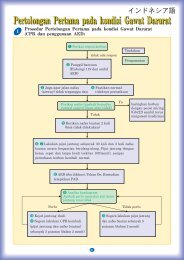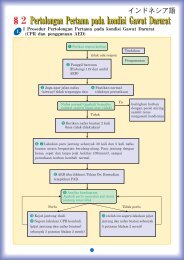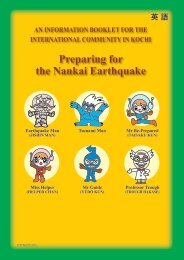Contents
Preparing for the Nankai Earthquake
Preparing for the Nankai Earthquake
- No tags were found...
You also want an ePaper? Increase the reach of your titles
YUMPU automatically turns print PDFs into web optimized ePapers that Google loves.
1The Nankai Earthquake WILL Occur1Movement of PlatesKochiPrefectureEurasiaPlateWhat Causes Earthquakes?The surface of the earth is comprised of massive rock plates that are tens of kilometers thick. Theseplates move at an extremely slow rate of several centimeters per year.In the middle of Tosa Bay, the Philippine Sea Plate is slowly being pushed beneath the EurasianPlate. Over time, stress builds up along the boundary between these two plates. When this stressbuilds to a point that can no longer be withstood, the plate that was pulled under will slip back up toits original position, resulting in the Nankai Earthquake.When this occurs, all areas in Kochi Prefecture will experience very serious tremors. Furthermore,because the sea floor will rise and fall, a Tsunami will also occur.2Ocean TrenchPhilippine SeaPlateKochiPrefectureAccumulation of StressPrevious Nankai EarthquakesKochiPrefectureOccurrence of TsunamiThe Nankai Earthquake Repeats!Historically, the Nankai Earthquake occurs every 100 to 150 years. The most recent occurrence wasin 1946. The scale of this earthquake was quite small, meaning there is still a great deal of stress leftto be released. As a result, there is a strong likelihood the fault-line will not wait the usual 100 years,and the next earthquake can be expected in the first half of this century.The Nankai Earthquake has occurred almost concurrently with the nearby Tonankai Earthquake.There is a strong connection between the two seismic events. As a rule, the Nankai Earthquakefeatures both large tremors and a tsunami. However, the 1605 Keicho-era Nankai Earthquake wassmall, yet still caused a very damaging Tsunami.The 1946 Nankai EarthquakeThe previous Nankai Earthquake occurredon December 21st 1946 at 4:19am. Theepicenter was on the sea floor 50km off thecoast of Cape Shiono in Wakayama, andcaused massive damage throughout Kochiand western Japan. The earthquake was ofmagnitude 8.0.Kochi suffered large tremors, and coastalareas were inundated by waves of 4~6meters. Sadly, 679 people lost their lives,and 1836 were injured. 4846 buildingscollapsed or were washed away.Map of Sea Floor (from Hydrographic and Oceanographic Office,Japan Coast Guard)Pink areas are the assumed epicenter zones of the NankaiEarthquake (Left) and Tonankai Earthquake (Right)This wide area is expected to be affected by the earthquake
5Characteristics of the Next Nankai Earthquake1) Strong ShakingThe next Nankai Earthquake is expected to be around magnitude 8.4 (about 4 times the size of the 1946occurrence). Most areas of the prefecture will experience strong tremors of seismic intensity strong 5 to strong 6(some areas will be 7). These tremors should continue for around 100 seconds.Predicted Distribution of Seismic IntensitiesThe 2 nd Kochi Basic EarthquakeManagement Study, March 2004Seismic IntensityWeak 5Strong 5Weak 6Strong 632) Land Subsidence and Inundation by SeawaterThe earthquake may cause the land in some areas to sink, leading to inundation with seawater prior to thearrival of the tsunami. In 1946, the land around Cape Muroto and Cape Ashizuri was upraised, and the centralregion around Kochi City sank.3) LandslidesLandslides caused by earthquakes can give rise to a phenomenon called Mountain-Tsunami. This occurs whena landslide blocks a river, forming a temporary dam that holds back a lake. When this unstable dam breaks,water and debris rush down the valley, forming a tsunami from above. This may also occur after heavy rains,not just after earthquakes. It is particularly concerning if an earthquake strikes during a time of heavy rain. Beparticularly careful if the river exhibits any changes after an earthquake (eg. a change in water-level, or the riversuddenly goes murky)4) Large TsunamiThe next Nankai Earthquake will give rise to large tsunami over 3m high. These will hit coastal areas very soonafter the earthquake.5) Predicted DamageThe Predicted Damage to Property and People from the Next Nankai Earthquake(Assuming the earthquake hits in the early morning when most people are asleep.)(2nd Kochi Basic Earthquake Management Study, March 2004)Number ofbuildingsdestroyed(Excludes partlydestroyed/damaged)Total By tremors By tsunami By landslide By fire By land liquefactionApprox. 81,600(15.4% of all530,000 buildingswithin theprefecture)Approx. 31,200 Approx. 35,700 Approx. 9,900 Approx. 2,700 Approx. 2,100Total Total Killed Total InjuredKilled andInjuredApprox. 20,390(2.5% of the810,000 people inKochi – from 2000Approx. 9,630 (1,800 by buildingcollapse, 7,000 by tsunami, 680 bylandslide and 150 by fire)Approx. 10,760(9,340 by building collapse,850 by landslide and 570 by fire)Census)
6InundationDepth (m)Predicted Seismic Intensity and Tsunami Inundation・Finding Your Evacuation PointPredicted Seismic Intensity and Tsunami InundationTo be properly prepared for the Nankai Earthquake requires us all to be fully aware of the predictedseismic intensity and tsunami vulnerability of the places we live and work. Accurate information isavailable from the Nankai Earthquake Information Display on the 1st floor of the Prefectural Office,at the disaster prevention departments of local governments, and also online. The website below isなんかいじ しん そなonly available in Japanese, so will only be useful to those who can read Japanese “ 南 海 地 震 に 備 えてGOOD!!”.Homepage URL : http://www.pref.kochi.jp/῀shoubou/sonaetegood/index.htmlTsunami Inundation: Kochi CityIf backup tidal barriers do not operateTime until Tsunami Inundation: Kochi CityTime untilarrival(minutes)If backup tidal barriers do not operate(Kochi Prefecture Supplementary Assessment Study for Tsunami Disaster Prevention, May 2005)Finding Your Closest Evacuation PointBe sure to check the location of the evacuation points in your area. Also remember to check how to getthere, and how long it takes. Especially for those living in Tsunami-prone areas, it is vital to be aware ofwhich areas will not be inundated (eg. tall strong buildings, hills)7Preventing Building Collapse1) Checking the Earthquake Resistance of Your HomePreparing for the Nankai Earthquake4Heavy Roof Few Walls Weak Foundations OldCan your home withstand a large earthquake? Just like you have health checkups, it is important thatyou check the earthquake resistance of your residence to see if it is safe.The earthquake resistance of many structures built before 1981 is questionable. Having your homechecked for earthquake resistance can be organized through your local government office, and costs¥3,000, current as of 2007.Buildings Eligible for Earthquake Resistance Testing:※ Wooden homes of traditional Japanese design whose construction started before May 31 st 1981(free-standing houses, terraces and multi-purpose homes whose main purpose is as a dwelling)
■What is Earthquake Resistance Testing?Earthquake Resistance Testing is a comprehensive survey of your house’s durability in an earthquake. Thetest looks at the state of the ground and foundations, how balanced the layout of walls is, the number of walls,and the structural integrity of the house. (If you live in rented accommodation, please talk with your landlordabout taking this test)❶ Ground・FoundationsReclaimedLand etcGood ground supportPoor ground support✔Steel ReinforcedConcrete SlabFoundationNo SteelReinforcementCrackedOther foundations:stone, stone-pileand block-pilefoundations❷ Balanced Distribution of Walls❸ Number of Walls❹ Structural Integrity of House✔Regular DesignLarge number of walls✔Irregular DesignSmall number of wallsOld structureRotten or eatenby termites52) Improving Earthquake ResistanceIf your home is shown to have insufficient earthquake resistance, you will need to reinforce the building. It is veryimportant to have a detailed refurbishment plan to ensure your home is strengthened. Be sure to speak with trustedinstitutions, such as your local architect or a building company. (Most companies will not be able to deal with English,so please have a Japanese-speaking friend accompany you)Think about EarthquakeResistance ReinforcementRequest Plans forResistance Reinforcementfrom ProfessionalsPlan for detailed surveysand reinforcementby professionalsEarthquake ResistanceReinforcement Works❖Before any reinforcement work is done, be sure to receivean Earthquake Resistance Reinforcement Plan.Renovating your home is a great chance to improve theearthquake resistance of your house. If you have anyreservations about the contents of your EarthquakeResistance Reinforcement Plan, feel free to call the HousingEarthquake Resistance Center on 088-825-1240. They offerfree vetting of reinforcement plans provided by your builder(Only in Japanese).Collapsed Buildings from Niigata Chuetsu Earthquake (Nagaoka City, Niigata Prefecture)
3) Upkeep of BuildingsWithout proper upkeep, even strong buildings will become vulnerable to earthquakes over time. Earlyprevention is the best policy. If any of the items below apply to your home, please contact the HousingEarthquake Resistance Center or similar body (Japanese only).OutsideInsideIf you have a tiled roof,are any tiles dislodgedor cracked?Are the underside of youeaves rotten, or are thereany gaps?Are there any cracks inmortar walls?Are there holes or signs ofrotting in walls clad withwooden boards?Are there cracks in thefoundation?Does rain leak inside?Are the floors damaged, ordo they creak when you walkon them?Do marbles or round pencilsroll by themselves on yourfloor?Do doors and windows notfit well, or are they hard tomove?During a typhoon, does yourwhole house often shake?Is the ground rotten, or arethere signs of termite damage?4) Checking Block-WallsWalls made from concrete blocks or rocks can collapse during an earthquake, trapping people underneath,blocking roads and impeding the movements of emergency services after the disaster. These structures shouldalso be thoroughly checked.6Does the wall have a lot ofsee-through bricks, orunusually shaped bricks?Is the mortar between theblocks falling out?Is the cap-piece (top layer)separating from the restof the wall?Does the wallsupport any otherstructures?Are there any cracks,or is the wall leaning?Is the wall thickenough for its height?(15cm thick if over2m high)Is the wall unstable?Is the wall too tall?(Over 2.2m)Do the supporting struts protrudefrom the wall enough? (1/5 theheight of the wall)Does it have afoundation?つぎ なんかいじ しん そなSource: ‘ 次 の 南 海 地 震 に 備 えるために’, Kochi CityDoes the wall have supportingstruts? (At least every 3.4malong the wall)
5) Preventing Trouble when Contracting for RenovationsAdvice●Talk everything over with yourfamily.●Discuss it with your localgovernment or the HousingEarthquake Resistance Center(088-825-1240).Getting Renovations Done● Beware of builders who pressureyou to sign a contract by sayingthings like ‘It’s cheap if we startimmediately’.● Compare quotes from severalbuilders.Building Contracts●Be sure to receive a written agreement (contract papers, blueprints,written quote).●Under relevant trade practices legislation (Tokutei Shotorihikiho), youhave an 8-day cooling off period after signing any contract (you mayback out of the contract for any reason). Even if a contract does notstipulate a cooling off period, you may still cancel the contract withinthese 8 days.●If you have any reservations about the contract, or encounter anyproblems, feel free to contact the Kochi Prefecture Consumers Center(088-824-0999).6) Advice is Available!Every local government has an earthquake resistance advice center. You may also speak with the HousingEarthquake Resistance Center. (Japanese Only)7■List of Contact DetailsAdvice Given Name and Contact Details Hours NotesEarthquake Resistance Testing.Free advice on renovations.Housing Earthquake ResistanceCenter(within the Kochi Association ofArchitectural Firms)TEL: 088-825 1240FAX: 088-822-117010:00 ~ 16:00weekdays (except public holidays)ksjk@i-kochi.or.jpURL:http://www.ksjk.or.jpEarthquake resistance testing,renovations and design. Freeadvice about building design.Referral to builders who cando earthquake resistancereinforcementAdvice on loans for refurbishment※Advice on use of housingperformance indication system※※Advice on use of housingperformance guarantee systemKochi Association of Architectural FirmsTEL: 088-825-1231FAX: 088-822-1170Kochi Architectural DesignSupervision AssociationTEL: 088-872-4901FAX: 088-824-8107Kochi Architects AssociationTEL: 088-822-0255FAX: 088-822-0612Kochi Construction Association,Architecture DivisionTel. 088-824-6171FAX: 088-824-6173Kochi Construction UnionTEL: 088-823-0058FAX: 088-873-5384Shikoku Branch, Japan HousingFinance AgencyTEL: 057-088-6035FAX: 087-826-6454Kochi Prefecture ConstructionTechnology Public CorporationTEL: 088-850-4650FAX: 088-892-14959:00 ~ 17:00weekdays (except public holidays)9:00 ~ 17:00weekdays (except public holidays)9:00 ~ 17:00weekdays (except public holidays)9:00 ~ 17:00weekdays (except public holidays)9:00 ~ 17:00weekdays (except public holidays)9:00 ~ 17:00weekdays (except public holidays)9:30 ~ 16:00weekdays (except public holidays)Please tell us what you need todiscuss in advance. We will contactyou with a time for you to cometalk with us.ksjk@i-kochi.or.jpLocation: Ecoasu Umaji-mura(22-33 Minami-goza, Kochi City)Time: 2 nd and 4 th Saturdays everymonth, 13:00 ~ 15:00. Pleasecontact us in advance.TEL: 088-880-1812FAX: 088-880-1815Please FAX or email us with yourquestions in advancesikai780@mb.inforyoma.or.jpLocation: Kochi Shimbun TakasuHomes GalleryTime: Every 2 nd and 4 th Sunday,11:00 ~ 16:00※Basic standards regarding theperformance of both new and preexistinghousing are stipulatedby national legislation. Thisallows homebuyers to comparedifferences in durability ofbuildings.※※Advice regarding the qualityand performance of buildingscarries a guarantee of up to 10years
8Preventing Furniture Overturning etcThe large tremors of an earthquake can overturn furniture, and buildings with low earthquake resistance maycollapse, causing great injury and loss of life. Broken glass and crockery can also cause injury.About 80% of deaths and injuries in the Hanshin Awaji Earthquake resulted from falling furniture or thecollapse of buildings. Purely bracing furniture and strengthening homes can avoid much of the damage causedby tremors.Injury can also be avoided by ensuring broken glass and crockery does not fall on the ground.1) Preventing Furniture from Overturning■What will my furniture do in an earthquake?During an earthquake, furniture can overturn, ‘walk’ around the room, sway, jump, fall, or slide around thefloor (see picture).overturningʻrockingʼ migrationswayingjumpingfallingG G GFurniture, fridges,pianos canoverturnFurniture can ʻwalkʼ intocorridors, blocking themFurniture can crash intowalls and floors, damagingthe things stored inside(may fall over dependingon floor material)Furniture and TVs canjump and fall on thefloorStacked furniture andtable-top cupboardscan fall■State of a room after the Great Hanshin Awaji Earthquake8A home (Provided by Kobe City Media Department)An office (Provided by Hyogo Prefecture Media Department)■Things to remember(1) Never place tall furniture on carpets or tatami (rice straw) matsPlace tall furniture on hard floors, not soft ones. Thisis especially important for furniture on floors aboveground level(2) Store heavy things lower, and lighter thingshigher in your wardrobesDon’t place dangerous items such as glass/irons on top offurniture. Similarly don’t put heavy things like TVs up high.Floorboards are safer than carpets or tatami (rice straw) mats.× ✓ × ✓
(3) Using Furniture FastenersFurniture fasteners act as cheap insurance. Be sure to choose the right fastener for the job.(For those who rent, please get permission from your landlord first)L-Plate FastenersIt’s better to attachfasteners to strongareas (posts, jambs,walls, windowsills, lining,hardwood)Attach fasteners tothe strong skeleton ofthe furniture9Fasten furniture with achain/belt. Make surethe angle in under 30°and there is no slackWithin 30°Strengthen fake door jambs.These are not securely attachedto posts, so be sure toreinforce them withfastenersMake sure it is taut.Attach to both sides of furniturePut film on glass toprevent shatteredglass from fallingPut down a rubbermat to stop thingsfrom sliding outMovable fasteners◦ How to attachUse L-shaped fasteners to attach to wallsStacked furniture should be fastened together*If you cannot use screws in yourwalls◦ Have furniture lean back into the wallAt the very least, have the furniturecompletely upright. Having the frontout and side slightly raised so that thetop hits the wall behind is betterNowIʼm SafeInsert something like adoorstop. Also insert anextendable brace betweenthe roof and the top ofthe furniture◦Using fastenersproperlyThe effectiveness of fastenersdepends on where you attachthemPopSorry!◦ Adhesive tapeUse adhesive tapeto stop furniture likeelectrical appliances fromoverturningUse longer screwsfor woodNextscrewplease!
(4) Rethink the Layout of your FurnitureDon’t place furniture in bedrooms or near exits.SleepingAreaFalls Over hereItʼs best to sleep to theside of furnitureSleepingAreaFalls OverhereIf you sleep in front of furniture, ensure the distance betweenyou and the piece of furniture is greater than its heightTVJumps orfallsSleeping AreaCannot escapeExitFalls OverhereDoor willnot openFurniture(5) Securing Appliances and Pianos etcRefer to the manual, or talk to the maker or placewhere you bought your appliance for informationabout securing your heavy furniture.When buying new electrical appliances like TVs orcomputers, it’s best to choose items that are not too heavy.(6) Throw away or recycle things you don’t needDon’t let old clothes and magazines pile up aroundthe house. A house free of clutter will make it mucheasier to escape in an emergency.2) Preventing Injury from Broken Glass▪ Attach shatter-proof film to glassAt the very least, make sure you use shatter-proof film on glass in areas that you are often barefoot. Forexample, your bedroom, living room, and bathroom.▪ Secure expensive items with adhesive putty▪ Ensure crockery cannot bounce out of their cupboards9Are My Family and Friends Safe?10There is a possibility that you will not be with your loved ones when disaster strikes. It may also not be possiblefor you to reach your home, so you should decide a family meeting place in advance. For example, arrange tomeet at your local evacuation point, or a friend’s house. Be sure to have the full contact details for the workplaceand schools of all your relatives. Also, if you are forced to leave your home, be sure to post a note to the doorletting your loved ones know how to contact you. It is most important that you decide appropriate methods tocontact one another in the event of an earthquake.It will be very difficult to get through to people using phones in the case of an earthquake. However, there is amessaging service that could be of use.Emergency Messaging Service – Dial 171In the event of an earthquake stronger than a weak six, the NTT Emergency Messaging Service will come intoservice. There is no need to register in advance. This service allows you to check whether your loved ones arealive and well in the event of an earthquake.※ TV and Radio will report if this Messaging Service is in operation or not.Recording a MessageListen to InstructionsDial the number of the phone to which you want yourmessage to be sent.Listen to InstructionsListening to a MessageListen to instructionsDial the number of the phone whose messages you wantto hearListen to instructions Be sure toListen to InstructionsBe sure toListen to instructionsdial the area code firstdial the area code firstRecord message (30secs)Listen to the message(s)
10Emergency Supplies for When You Evacuate and for Life in a ShelterThere is a difference between supplies for evacuation andsupplies for life in shelters.Emergency Supplies for When You EvacuateWhen an earthquake strikes, you need to be mobile so as to escape quickly. Emergency supplies at this timeshould be limited to your valuables and items necessary to survive in the hours post disaster.●Glasses, Hearing Aids, False Teeth,Prescribed Medication●Helmet, Fire-Hood, Sensible Shoes● Torch, Portable Radio, Spare Batteries●Cash (include change),Valuables● Passport, Alien RegistrationCard, Insurance Card(s)Emergency Supplies for Life in a ShelterAfter an earthquake it will be difficult to obtain water, food and other necessities. Each household must storeenough food and water to survive until assistance from the outside world arrives. If you live in an area that willbe inundated by a tsunami, you will not be able to return to your home. You will need to store your emergencysupplies at an evacuation point. You will need at least 3 days worth of supplies. So make sure you stockpileenough!11● Drinking Water : 3L of drinkingwater per person per day is required.WaterWaterWaterWater● Food : Tap water, electricity and gas will not be availablefor an extended period, so consider the following whenstockpiling1 Food that can be stored for long periods at room temperature2 Food that does not require cooking3 Non-bulky foods that save space in storage4 Foods high in calories and nutrients5 Food appropriate for the elderly or babies● Other : considerations specific to thelifestyle and religious circumstances of eachhousehold, such as food for vegetarians,powdered milk, nappies etcItems Useful for After an Earthquakecrackerspowdered milkpre-cooked rice● Items Required Due to BlackoutsTorch (One for each room), Portable Radio,Batteries● Items Required Due to Water Stoppage (To Save Water)Plastic Cling Wrap (line plates before use), PlasticBags(can be used as makeshift raincoats)● Items Required Due to Lack of Gas/HeatingPortable Stove, Disposable Heat Packs● Sanitary ItemsTowels, Toilet Paper, Wet Wipes, Underwear, EmergencyMedicine, Female Sanitary Products, Nappies, Gauze Masks● For Use During Rescue and RecoveryThick Gloves, Crowbars, Jacks, Shovels● Items Required Due to Lack of Public TransportBicycles, Motorbikes● Small Change to Make Public Phone CallsHeatPacks
Advice on How to Store Your Emergency Supplies in Your Living Space1 Supplies for Evacuation : Collect all the supplies in one visible placelocated on the route you will use to escape. Beside your bed is a good idea.You could also put them in a carry-bag, and hang it from your wall for easyaccess.2 In case an earthquake strikes at night, you should place such things as atorch, a radio and slippers beside your bed.3 Make a habit of stockpiling water and food when you go shopping. After atime, use up the old supplies, and buy some new ones.Medicine11Health and Earthquake InsuranceTaking Out Health InsuranceIf you don’t take out health insurance, costs for treating any injuries sustained in an earthquake must be borneentirely by you. First, check if you are already enrolled in a health insurance scheme, and if you are not, thenapply.Taking Out Earthquake InsuranceFires caused by earthquake are not covered by fire insurance. To cover your home and property for damagecaused by an earthquake, you will need to take out both fire and earthquake insurance. However, it is not possibleto take out earthquake insurance alone. Earthquake insurance is based upon the ‘Law Regarding EarthquakeInsurance’ and involves a public-private partnership between the government and insurance companies.In the case of a disaster, payment will depend on the extent of the damage. In case of total destruction, you willreceive 100% of the insured amount; if half-destroyed, then you receive 50%; if partially destroyed, then youreceive 5%. For further information, please contact Sonpo Japan (0120-107808, http://www.sonpo.or.jp) or itsShikoku branch (087-851-3344). (Japanese only)1212Getting Involved with Local Disaster Prevention Groups1) What is a Local Disaster Prevention Group?These groups are based on the principle of localpeople looking after their fellow locals in their hour ofneed. There is no special need to set up a new group.Pre- existing groups, such as town committees andresidents’ associations can adequately fulfill this rolemerely by conducting annual disaster drills.■Rescues Made in the Hanshin AwajiEarthquake40.030.0% 20.034.931.928.12) Why Do We Need Such Groups?When the Nankai Earthquakeoccurs, it may not be possible tolaunch adequate rescue efforts(such as fire fighting). As a result,if people are injured or firesbreak out, cooperation with thosearound you will prove vital.10.00%by oneselfby familyby friends/neighborsIn the Hanshin Awaji Earthquake, around 95% of people who survivedbeing buried under rubble or being trapped in their homes wererescued by family/neighbors or managed to escape by themselves.2.6by passers-by1.7by Rescue Squads0.9Other
3) Activities of Local Disaster Prevention Groups1Understanding DisastersIt is important to be aware of the damage expected in your local area.For example, you need to know about the predicted seismic intensity, tsunami-inundation, river-overflow, fireand landslide dangers for your local area.2Know Your Local AreaYou should check the evacuation points and evacuation routes in yourlocal area. It is also important to be aware of which residents will need tohave special help in case of a disaster, for example the infirm, the agedand the disabled.It could be helpful to prepare a Disaster Prevention Map.3Disaster DrillsMaking a Disaster Prevention MapConducting drills is a good way to protect yourself from injury.For example, you could maintain your evacuation points/routes, stage a mock evacuation, maintain andpractice using equipment such as fire extinguishers.4) Disaster Prevention at your Work or SchoolApart from local groups, disaster prevention activities are sometimes conducted at workplaces and at schools.By actively participating in these activities, you will form deeper ties with your local community, and create anenvironment of cooperation that will be of use not only in case of a disaster, but also in your everyday life.Even those who are not confident at speaking Japanese could benefit from exchanging simple greetings, suchas ohayo, konnichi wa, konban wa, and oyasuminasai (good morning, hello, good evening and good night,respectively). This will foster bonds between you and your community.131Take a First Aid CourseIf you don’t actually practice first aid,you will not be able to act effectively in anemergency.Each local fire department conductsseminars. Individuals and groups may applyto participate.The course takes 3 hours, and is free.2 Learn How to Extinguish a FirePlease speak with your local firedepartment.3 Joining a Local Disaster PreventionGroupPlease make enquiries at the disasterprevention section of your local governmentoffice.5) Disaster Prevention Week, etcThe central government, local government agencies and other disaster prevention bodies cooperate to raiseawareness of typhoons, deluges, heavy snow, floods, tidal inundations, earthquakes and tsunami etc. DisasterPrevention Day and Disaster Prevention Week have beeninstituted to prevent and/or reduce damage by encouragingpeople to prepare for disasters in advance. Intensive disastertraining and disaster-awareness activities that involve manycitizens are conducted across the country during theseperiods.At present, these special periods are: Disaster PreventionWeek (Aug 30-Sep 5), Disaster Prevention Day (Sep 1),Disaster Prevention Volunteers Week (Jan 15-21), DisasterPrevention Volunteers Day (Jan 17), Flood Prevention Month(May). People from overseas are encouraged to make use ofthese opportunities to learn and prepare for disasters.Foreigners participating in a disaster drill inIbaraki Prefecture during the 2007 DisasterPrevention Week
When the Nankai earthquake occurs, its severity is expected to cause major, simultaneous damageto all areas of Kochi. As a result, no matter where you are in the prefecture it will be difficultfor emergency relief authorities to rescue you or guide you to safety. It is vital that you takeresponsibility for PROTECTING YOURSELF.13If You Are at Home or Inside a BuildingFalling furniture, broken glass and buildings with low earthquake resistance can become deathtraps. (See page 4-10 for how best to prepare for an earthquake)1) If You Are in a RoomLarge furniture, bookshelves andpicture frames may fall, so you shouldtake cover under a sturdy table or desk.14If You Are Outside1) If You Are in the StreetIf you are walking near a building,beware of falling objects like glassand signboards, cover your head withwhatever you are carrying, and find asafe place to take refuge.2) If You Are in an ElevatorIf your elevator has an earthquakesensor, it will stop at the closest floor.If not, as soon as you sense a tremor,press the button for every floor, andget off wherever the elevator stops.2) If You Are Near a Brick WallImmediately move away from brick walls as there isa danger they will collapse.Surviving the Nankai Earthquake143) If You Are On a BridgeRun to the closest end of the bridge andget away from the structure. If you areunable to move, squat down low and holdonto the railing to make sure you are notthrown from the bridge.5) If You Are Near the Ocean or a RiverTsunami are a danger here, so run away from waterand head for high ground. Tsunami travel far up rivers,so keep this in mind.※ If you are near the coast, to prevent being caughtby sudden tsunami always keep in mind where theclosest high ground or tall building is located.4) If You Are in the MountainsMove away from the top or base ofcliffs.
15If You Are in a Vehicle1) If you are DrivingAs soon as you feel a tremor, slow down gradually,calmly pull over to the left and turn off your engine.If you are at the base of a wide slope or at the mouthof a tunnel there is a danger of landslides, so avoidparking your car in these locations.When you leave your car, leave the doors unlockedand the keys in the ignition.Do not leave valuables in thecar.When leaving your car, becalm and avoid being hit bypassing vehicles.2) If You Are in a Bus or TrainPrepare for rapid braking by using a seatbelt, orgrabbing hold of a handrail. Calmly follow theinstructions of the driver or conductor.Leavethe Keys inthe Ignition16Earthquake Early Warning System15Recently, a system has been put in place to giveadvanced warning of an imminent earthquake via TV,Radio and other media. This system quickly detects anearthquake and broadcasts news of its approach, givingfrom several seconds to tens of seconds notice. However,if you are located close to the epicenter, the strong tremorsmay reach you before the warning. If you hear this earlywarning system, calmly and carefully move to a safelocation, cover your head, and make sure you will not beinjured by the things around you when the shaking starts.17Surviving a Tsunami1) Characteristics of a Tsunamiso you mustescape to the thirdfloor or higher.Provided by NHKImage of the Early Warning System : Kochi Meteorological Observatory Tsunami reach A Tsunami is shore between 3a series of wavesTsunami are highand 30 minutesWaves can keepafter the tremorscoming for 6 hours.begin5Not all tsunami begin with the tide going out.6The first wave may not be the biggest.Rivers and canals overflow asthe tsunami moves upstream7911Tsunami waves can be extremely high at the tip ofcapes and in the interior of harbors.Even if the tsunami is only knee-high, you will notbe able to stand up and will be washed away.You may not be able to steer your boat properly ifyou are in a harbor.81012The height of the tsunami and the time it takes to arrive depend uponthe magnitude of the earthquake and the location of its epicenter.The tsunami undercurrent is very strong, and youmay be washed out to sea.Currents are most severe at the mouth of narrowharbors or near the edge of breakwaters.
2) Damage Caused by Tsunami1 People drown and houses are destroyed.2 Objects are washed away, crushing people andblocking roads and waterways.3 Fires Break Out.4 Harbors are strewn with debris and ships are notable to dock.View of Aonae-chiku, Okushiri Town, Hokkaidobefore earthquake. (Provided by Okushiri Town)3) How to Escape the TsunamiTremorsGet ReadyRUN!Wait for6 hoursAfter 100 seconds or so, the large tremors should die downDO NOT wait for instructions. Collect your pre-prepared emergency supplies (glasses, medicine,portable radio, torch etc) and evacuate immediatelyRun as fast as you can to the closest high ground.If there is no high ground close by, climb to at least the 3rd floor of a steel-reinforced concrete building. Asa rule, do not use a car to evacuate.A Tsunami is a series of waves. Do not leave your safe location until you confirm via radio that the Tsunamialarm/warning has been lifted. If you cannot confirm this, wait at least 6 hours before moving to lower ground.4) Preparing for a Tsunami1 Find your closest evacuation point.2 Decide upon a route to get to this point.It is best to actually walk the route inadvance.3 Remember what the sign for a TsunamiEvacuation Point looks like.18㆖Tsunami Evacuation Point (Standarddesign throughout the Prefecture)➡Tsunami Evacuation Point(Standard national design)Dangers After the EarthquakeThe same area after being struck by a tsunami causedby the Hokkaido Nansei Oki Earthquake. Morning of 13 thJuly 1993 (The day after the earthquake) (Provided byKyodo News)※Both designs are currently used within Kochi, but the prefectural design will be phased out.161) Dealing with FireIf fires seem to be spreading, evacuate to an open spacelike a park.2) Dealing with AftershocksPay close attention to the aftershock predictions issuedby the Meteorological Agency. Do not enter damagedbuildings. Do not approach places that are in danger oflandslide.3) Dealing with ‘Mountain Tsunami’Landslides caused by earthquakes can form unstabledams across rivers. When the dam breaks, downstreamareas are hit by mudslides. If such a dam blocks a river,evacuate from the area.Imokawa, Nagaoka City (formerly Koshi-gun Yamakoshi Village)Provided by Hokuriku Regional Development Bureau, Ministry ofLand, Infrastructure and Transport
174) Extinguishing FireYou have 3 opportunities to put out fires1 When you first feel small tremorsIf possible, put out all fires when you first hearrattling.2 When the tremors die downYour first priority is to ensure you own safety, so waituntil the tremors die down before fighting any fires.3 When fire breaks outIf you put it out within 1-2 minutes, it will notspread. Act when the fire is still small.FIRE!!1 Quickly Let People KnowYell ‘Kaji’ at the top of your voice to let yourneighbors know.2 Extinguish the FirePut it out quickly before the flames reach the roof.3 Run AwayIf the fire reaches the roof, run away immediately.Prepare a Fire ExtinguisherPull outthe safety pinSqueezethe leverPoint thehose at thebase of the firePlace a fire extinguisher in every home!In Case of Fire, Call 1191 Fire! (Ambulance!)Kaji Desu! (Kyuukyuu Desu!)か じ きゅう きゅう火 事 です( 救 急 です)。2 ○○○○ is on fire○○○○ga moete imasuも○○○○が 燃 えています。3 I’m injuredKega desuきゅう きゅう( 救 急 ・ケガです)。4 My address is ○○○○Juusho wa ○○○○ desuじゅうしょ 住 所 は○○○○です。5 My name is ○○○○Namae wa ○○○○desuな まえ名 前 は○○○○です。6 The closest landmark is ○○○○Mejirushi wa ○○○○desuめ じるし目 印 は○○○○です。7 My phone number is ○○○○Denwabangou wa ○○○○desuでん わ ばんごう 電 話 番 号 は○○○○です。19Sources of Information Post-EarthquakeYou can get information about seismic intensity, the extent of the damage, aftershock predictions and resumptionof transport, electricity, water and gas services from several sources. These include radio, TV, and prefectural/municipal announcements.Do not take notice of word-of-mouth information whose source is unclear.20Contacting Your Workplace and EmbassyIt is possible that your overseas family or embassy will contact the prefecture and municipalities to confirm thatyou are safe. As soon as possible after things settle down after an earthquake, try to contact your family overseasand your embassy here in Japan. It is also wise to contact your workplace or school.21Triage and the Medical ResponseEarthquakes result in a large number of people being injured, meaning there will be a shortage of doctors, nursesand medicine. Therefore, the medical response will prioritize treatment so as to save the lives of the highest numberof people possible. Doctors will give priority treatment to, or evacuate, those with the most serious injuries whohave a high probability of survival. Please be understating of this triage process and follow medical instruction soas to help save as many lives as possible.
22Life in a ShelterLife in a shelter involves much inconvenience.Everyone needs to cooperate to get through this difficult time.What is a Shelter?Shelters act as temporary accommodation that is generally set up at schools, community halls and parks inareas affected by a disaster, or in places subject to an evacuation advisory. Some residents’ associations and localdisaster prevention groups have selected open-spaces or vacant lots in their respective areas to act as sites forsuch accommodation if the need arose.1 When should I go to a Shelter?1 If your house has collapsed, hasbeen destroyed by fire or tsunami,has no electricity, water or gas, or isuninhabitable2 If your house is in danger of collapsein an aftershock or being buried in alandslide3 If you need totake shelterfrom firesor mountaintsunami3 Shelters Are a Source ofInformation and Help1 Shelters give out information about theearthquake and how to cope post disaster.They also distribute food and other necessities.2 They also provide temporary accommodationfor people who cannot live in their own homes.2 The Four Rules of Living in aShelter1 Keep on good terms with your residents’association and local disaster preventiongroup2 Because you will be living in a shared space,stick to the rules3To make your living space comfortable,cooperate and helpeach other out4 Be understanding ofthose with specialneeds, such as the ill,the aged, pregnantwomen and children.4 Who Comes to a Shelter?・Shelters give aid to a wide range of people,not just those who reside there. Peoplewho are still able to live in their homes,but must endure electricity, water and gasstoppages also use these facilities. They arealso provided with food and the variety ofservices on offer.???185 Living Somewhere Other than a ShelterSome people do not go to shelters, but choose to take refuge by living in a tent, or in their car. If you chose thisroute, please be aware of your own health and safety.After the 2004 Niigata-ken Chuetsu Earthquake, some people lost their lives due to living in their cars. In suchcramped conditions, blood clots formed in their lower limbs, then traveled to their lungs, brain or heart, blockingsmall blood vessels – otherwise known as economy class syndrome. Be sure to drink plenty of water, movearound regularly, and wear loose clothing to prevent this condition.
Miscellaneous23Becoming a VolunteerThe aged, the disabled, the injured, pregnant women, babies, and foreigners have been identified asindividuals who may require special assistance after a disaster. Many municipalities run a DisasterVolunteer Center staffed by people who can provide assistance to those – including foreigners – whoare in need, (to the extent this does not impinge upon their own safety and evacuation needs). Thesevolunteers participate in setting up and running shelters, the distribution of food and water, andprovision of translation/interpreting services.Registering as a VolunteerAnyone who can speak conversational Japanese with no difficulty is encouraged to register withthe Kochi International Association as a Language Volunteer. Registration is of course free. Aftervolunteers are given initial training, they are asked to provide translation/interpreting services whena disaster strikes, to participate in ongoing disaster prevention drills aimed at foreigners, and also toundertake ongoing translation/interpreting training. They are also asked to respond to requests fromother prefectures to provide interpreting assistance in times of calamity outside of Kochi.24Inspecting Your HomeIf your house is affected by an earthquake, you may take advantage of one of three typesof inspection regimes to determine the extent of damage. These are the ‘Emergency HazardDetermination’, the ‘Extent of Damage Determination’ and the ‘Damage Report for Disaster VictimCertification’. This section will clarify the difference between the often-confused ‘Emergency HazardDetermination’ and the ‘Damage Report for Disaster Victim Certification’.191) Emergency Hazard DeterminationThis system involves an assessor determining the extent of damage to a house in the earlyaftermath of the earthquake. The assessor will also check if the building is in danger of collapse inan aftershock, look for fallen walls/glass, and determine the danger of other building componentscollapsing. The aim of this system is to prevent death caused by secondary disasters.Depending on the outcome, a colored sticker will be placed on your house in a visible location.A red sticker denotes ‘UNSAFE’, yellow means ‘LIMITED ENTRY’ and green indicated‘INSPECTED’.As a rule, entry tobuildings labeled with ared sticker is prohibited!2) Damage Report for Disaster Victim CertificationThis system involves the determination of the extent of damage to a building from the perspectiveof property value. This is based upon the building owner submitting a ‘Disaster Victim Claim’ withtheir local authority. This report is the first step to obtaining Disaster Victim Certification. Becausethe results of this report will influence any insurance payouts and public financial assistance you mayreceive, it will be conducted in an official and precise manner, usually by local government officials.The purpose of these two systems is quite different. Even if you receive a red ‘UNSAFE’ stickerfrom the Emergency Hazard Determination, the Damage Report for Disaster Victim Certificationmay yield a less serious result, such as ‘half destroyed’ or ‘partially destroyed’.
25Earthquake Vocabulary and Phrases1) Vocabulary1 地 震 (jishin) Earthquake2 震 源 (shingen) Epicenter3 津 波 (tsunami) Tsunami4 避 難 (hinan) Evacuate/Escape/Take Shelter5 避 難 勧 告 (hinankankoku) Evacuation Advisory6 避 難 指 示 (hinanshiji) Evacuation Order7 避 難 所 (hinanjo) Shelter8 震 度 (shindo) Seismic Intensity9 余 震 (yoshin) Aftershock10 危 険 (kiken) Danger/Dangerous11 火 事 (kaji) Fire12 逃 げる (nigeru) Escape/Run Away13 揺 れる (yureru) To sway/shake14 安 否 (anpi) One’s Safety15 救 助 (kyuujo) Rescue16 救 援 物 資 (kyuuenbusshi) Emergency Provisions17 消 火 (shouka) Extinguish a Fire18 断 水 (dansui) Water Stoppage19 停 電 (teiden) Electricity Stoppage20 警 報 (keihou) Alarm21 注 意 報 (chuuihou) Warning22 行 方 不 明 (yukuefumei) Missing23 死 者 (shisha) Deceased Person202) Phrases123456○○に 連 れて 行 ってください。( ○○ ni tsurete itte kudasai)Please take me to ○○○○が 欲 しいです。( ○○ ga hoshii desu)I want ○○○○が 痛 いです。( ○○ ga itai desu)My ○○ hurts.家 族 が 家 の 中 にいます。(Kazoku ga ie no naka ni imasu)My family is in the house.○○ 語 が 話 せる 人 を 見 つけて 下 さい。( ○○ go ga hanaseru hito o mitsukete kudasai)Can you please find me a person who speaks ○○ ?○○に 電 話 をしてください。( ○○ ni denwa o shite kudasai)Please ring ○○
Seven Tips for Surviving the Nankai EarthquakeThose who have read through this booklet will by now have gained a basic understanding of theNankai Earthquake. The next important step is to actually put this knowledge to use by makingconcrete preparations. At the very least, you should ensure that you have put in place the followingseven tips. They are the key to saving your life when the inevitable earthquake strikes.If you have done less than three of the following, you are not adequately prepared.No Tip Y/N See page #123456Have you checked the predicted seismic intensity andtsunami inundation depth for the area where you live? Doyou know where your local evacuation point is located?Have you checked your home’s earthquake resistanceand/or strengthened your home’s ability to withstand anearthquake? Are you aware if your home was built in 1982or after?Have you secured your furniture so it will not overturn?Have you made sure the layout of your furniture is safe?Have you discussed emergency plans with your family?For example, have you decided a meeting place after anearthquake, and emergency contact methods, etc?Do you have at least 3 days supply of water and foodstored as an emergency supply?Do you have a torch, a portable radio and shoes besideyour bed at all times to facilitate speedy escape?This pamphlet is available in electronic form at the following addresshttp://www.kochi-kia.or.jpInformation provided by Kochi PrefectureMascots produced and provided by㈲やなせスタジオEnglish Translation by Matthew DouglasPublished March 2008 (First Edition)Planned and Issued by the KochiInternational Association (KIA)4-1-37 Honmachi, Kochi City, 780-0870TEL : 088-875-0022FAX : 088-875-4929Website : http://www.kochi-kia.or.jp/Email : info_kia@kochi-kia.or.jpp.2~p.4p.4~p.7p.8~p.107 Do you participate in local disaster prevention activities? p.12~p.13NAMEp.10p.11p.12Unauthorized use of this pamphlet’s photographs, illustrations and text is strictly prohibited.












